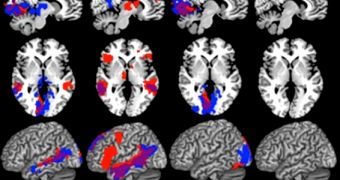A new study confirms and expands upon past proposals that the human brain may in fact be a lot more flexible than thought. The investigation revealed that the brain areas responsible for processing various stimuli can be recruited to perform other functions, if their primary one cannot be satisfied.
Generally, the brain functions in a very straightforward manner. Sensory input (vision, hearing, taste, touch and smell) are processed by the cortex, and each of the five is sent to its respective cortex.
Audio signals go to the auditory cortex, data from the eyes go to the visual cortex and so on. In people with all five senses, this is the way things are normally arranged. For many years, neuroscientists have thought that this type of arrangement was following a genetic blueprint of sorts.
But, over the past few years, studies have demonstrated that this is not the case. Some areas of the brain involved in processing a particular type of stimuli may be recruited to perform other tasks, if the stimuli they served disappears.
The landmark study that proved this was published in 1996, and demonstrated that blind people can use some of their visual cortex to aid them with reading the Braille alphabet. In the new study, experts from the Massachusetts Institute of Technology (MIT) expand on those conclusions.
Experts at the Institute reveal that the visual cortex can shift its function from understanding visual data to language processing. This is the first time evidence of involvement in language processing is found elsewhere than in highly-specialized language centers in the brain.
In order to produce and understand language, humans must be able to use two portions of their brains, called Broca’s area and Wernicke’s area. Without them, this task is impossible. But the MIT team showed that the visual cortex of blind people can participate in facilitating language as well.
“Your brain is not a prepackaged kind of thing. It doesn’t develop along a fixed trajectory, rather, it’s a self-building toolkit,” explains MIT postdoctoral associate Marina Bedny.
“The building process is profoundly influenced by the experiences you have during your development,” adds the expert, who is also the lead author of a new study detailing the findings.
The work will be published in the February 28 issue of the esteemed journal Proceedings of the National Academy of Sciences (PNAS). Bedny is based at the MIT Department of Brain and Cognitive Sciences.
“I think [the study] suggests that in principle, and if the changes are forced early in development and early in life, any brain area can change its skin and do any task or function,” says expert Amir Amedi.
“This is pretty dramatic,” adds the expert, who is a neurophysiologist at the Hebrew University of Jerusalem. He was not a part of the investigation.

 14 DAY TRIAL //
14 DAY TRIAL //